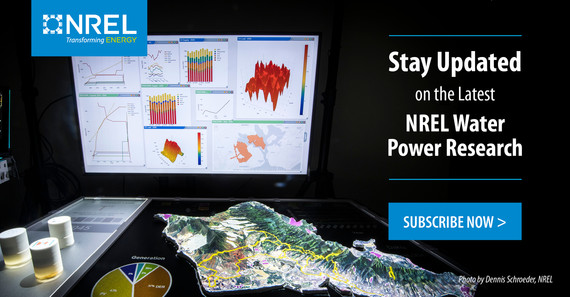|
Follow along on the Office of Energy Efficiency & Renewable Energy (EERE) Twitter, LinkedIn, and Facebook channels for more #WaterWednesday content each week.
Image of the Month
 The interior of the powerhouse of Natel Energy’s 300 kW Restoration Hydro Turbine at the Monroe Site in Madras, Oregon. Credit: Natel Energy
Want to see your hydropower or marine energy photo featured in our bimonthly Water Wire newsletter? It's easy! Just email your photo to WaterPowerTechnologiesOffice@ee.doe.gov with the subject line “Water Wire Image of the Month Contest.” In each edition of the Water Wire, we’ll feature our favorite water power photo at the beginning of the newsletter. Submissions are currently open for the next edition. Send your photos in now!
Upcoming Deadlines
Announcements & Opportunities

WPTO Accepting Applications for Hydroelectric Production Incentive Program: The Water Power Technologies Office (WPTO) is now accepting applications for the latest round of funding for the Hydroelectric Production Incentive Program under Section 242 of the Energy Policy Act of 2005. A total of $7 million is available for qualified facilities. New this year, additional hydroelectric facilities, such as those located in communities with inadequate electric service, may be eligible to receive incentive payments. Applications for funding are due Feb. 10, 2022.
Apply Now for Second Round of ETIPP Technical Assistance: ETIPP is accepting applications for its second year of technical assistance to support remote, island, and islanded communities. This program seeks to increase energy resilience through strategic energy planning and the implementation of solutions. Applications for technical assistance are due April 15, 2022. Register in advance to attend the ETIPP Webinar on Feb. 16 at 12 p.m. MST to learn more about the application process.
|
Products & Publications
DOE Premieres Inclusive Energy Innovation Prize Video: DOE recently released an overview video about the Inclusive Energy Innovation Prize. The prize will award a total of $2.5 million to groups that support entrepreneurship and innovation in communities historically underrepresented in climate and energy research communities. Watch the video to learn more about this new prize, and submit your application by Feb. 25, 2022.
Coming Soon: WPTO 2020-2021 Accomplishments Report: In the coming weeks, WPTO plans to release its 2020-2021 Accomplishments Report, detailing the largest successes from Fiscal Year 2021. One of the headline accomplishments is the launch of the PSH Valuation Tool. Developed by Pacific Northwest National Laboratory (PNNL) and Argonne National Laboratory, the online tool works with the PSH Valuation Guidebook and walks users through the step-by-step process of project valuation. Learn about this project and many more in the 2020-2021 Accomplishments Report, coming soon!
Upcoming Events
R&D Deep Dive Webinar: The Environmental Decision Support Toolkit and Relicensing
Jan. 26, 2022, 3–4 p.m. ET
The Federal Energy Regulatory Commission (FERC) licensing process for a hydropower facility, whether it’s a new project or the relicensing of an existing facility, can take five to seven years and put a large financial burden on the applicant. Oak Ridge National Laboratory (ORNL) researchers developed the Environmental Decision Support Toolkit to help hydropower facility operators, FERC representatives, and other stakeholders identify the potential environmental impacts of a proposed project and improve the efficiency of the licensing process. Join the team behind the toolkit for a walk through their online, interactive, and science-based questionnaire.
Register for the webinar.
R&D Deep Dive Webinar: Marine Energy Testing Needs
Feb. 9, 2022, 3–4 p.m. ET
Join the cross-lab team working to identify areas for future WPTO investments in laboratory testing infrastructure through a marine energy testing needs assessment. This team, made up of representatives from NREL, PNNL, and Sandia National Laboratories, will share preliminary analyses on testing needs and discuss opportunities to provide feedback. Researchers will incorporate feedback from marine stakeholders on testing needs into the final analysis that will inform infrastructure investments.
Register for the webinar.
In Case You Missed It
Webinar and Report Explore Hydropower Regulatory Process: In a November webinar, researchers from NREL and ORNL presented key takeaways from the Hydropower Licensing Report. Their findings describe which factors in the regulatory process can hamper projects and could help decision makers streamline the process while maintaining critical protections. To learn more about the report’s key takeaways, watch the webinar recording.
 NREL Launches New Water Power Newsletter: Subscribe to the NREL Water Power Newsletter to stay up to date on important research developments in hydropower, marine energy, and integrated water systems.
Submit Applications to Build EPSCoR-Laboratory Partnerships: DOE Office of Science released a Funding Opportunity Announcement geared toward building partnerships between the Established Program to Stimulate Competitive Research (EPSCoR) program and national laboratories. Applicants must propose scientific collaborations that partner academic institutions from eligible states and territories with research staff at DOE national laboratories. Applications are due April 7, 2022.
Social Spotlight

EERE on LinkedIn—Dec. 31, 2021
Curious how PSH—which provides 93% of the United States’ energy storage—works? When other energy sources make more electricity than is needed, that extra power pushes water up into a pool where it waits. Then, when needed—like during a heat wave—the water is released from that pool and flows down, spinning a turbine that creates electricity to power your lights, refrigerator, or other essentials. Learn more! Follow EERE on Twitter, Facebook, and LinkedIn for daily EERE news, announcements, and general clean energy content.
|
WPTO/DOE in the News
-
'Ocean Battery' Targets Renewable Energy Dilemma, Yahoo Finance via AFP, Joshua Melvin, Jan. 6, 2022
-
Former Coal Mine Will House New Pumped-Hydro Storage Project, POWER Magazine, Darrell Proctor, Jan. 5, 2022
-
Ocean Energy Needs a Lift to Go Mainstream, The Wall Street Journal, Rochelle Toplensky, Jan. 3, 2022
-
Department of Energy Issues Report on Hydropower Permitting, Lexology, Troutman Pepper, Dec. 21, 2021
-
Key to Reliable Renewables, Water Power Magazine, Suzanne Pritchard, Dec. 10, 2021
-
Infrastructure Act Will Pump $3B into Nation's Ailing Dams, Construction Dive, Julie Strupp, Dec. 7, 2021
|